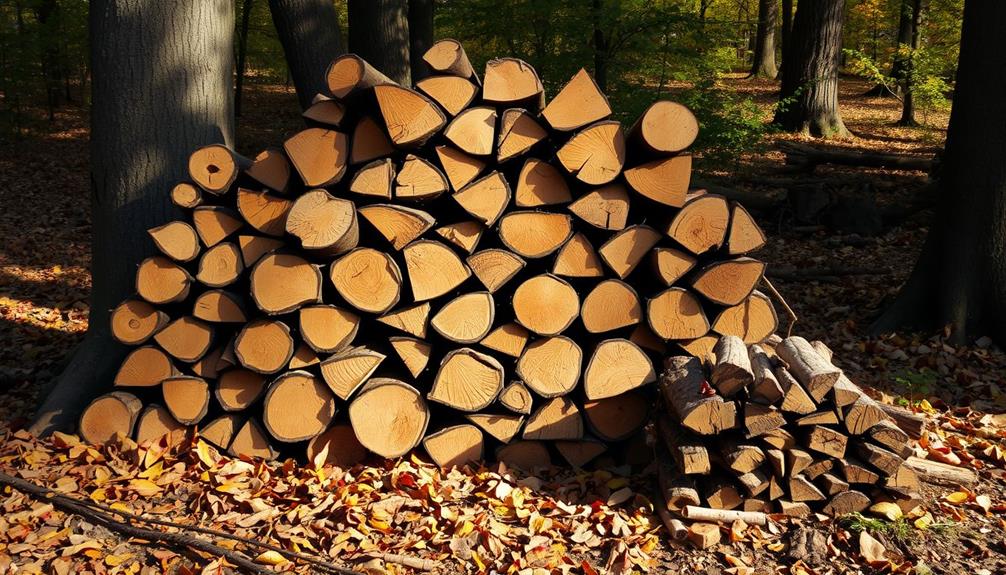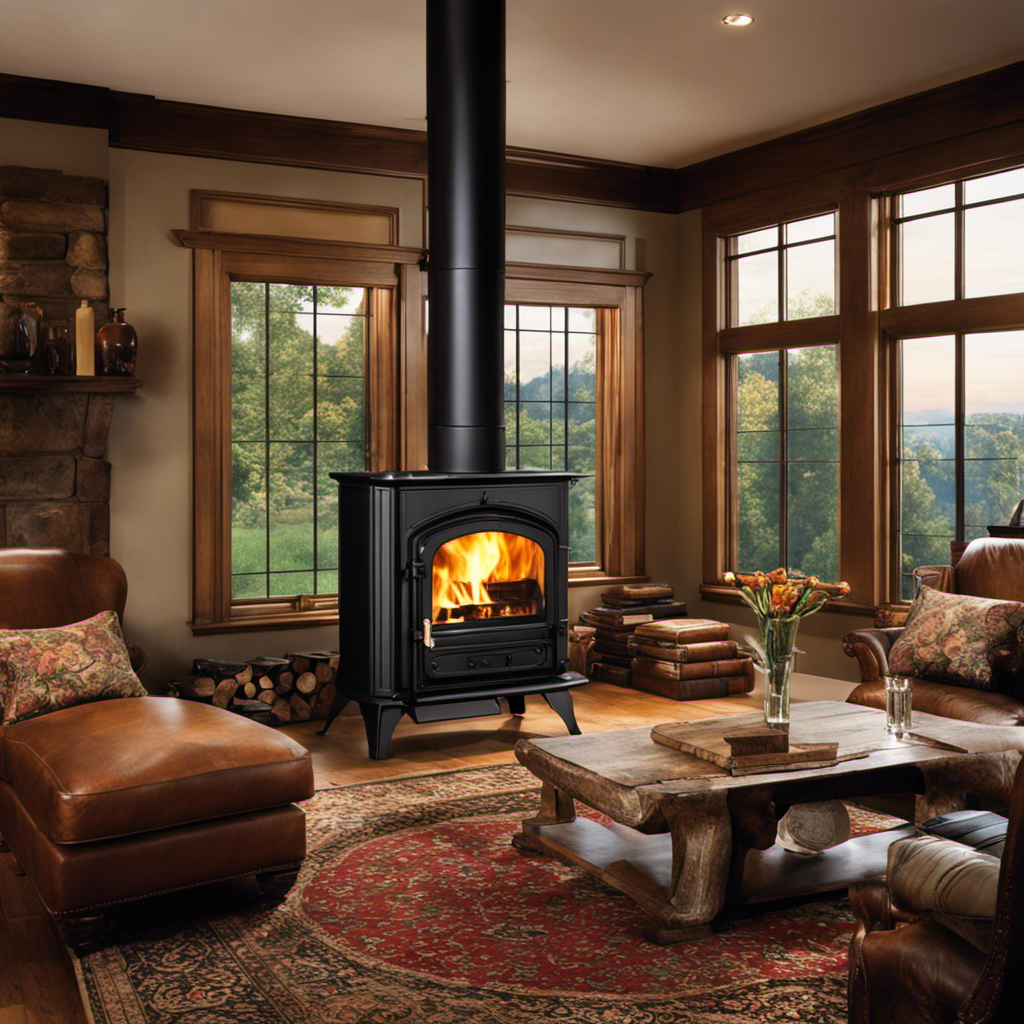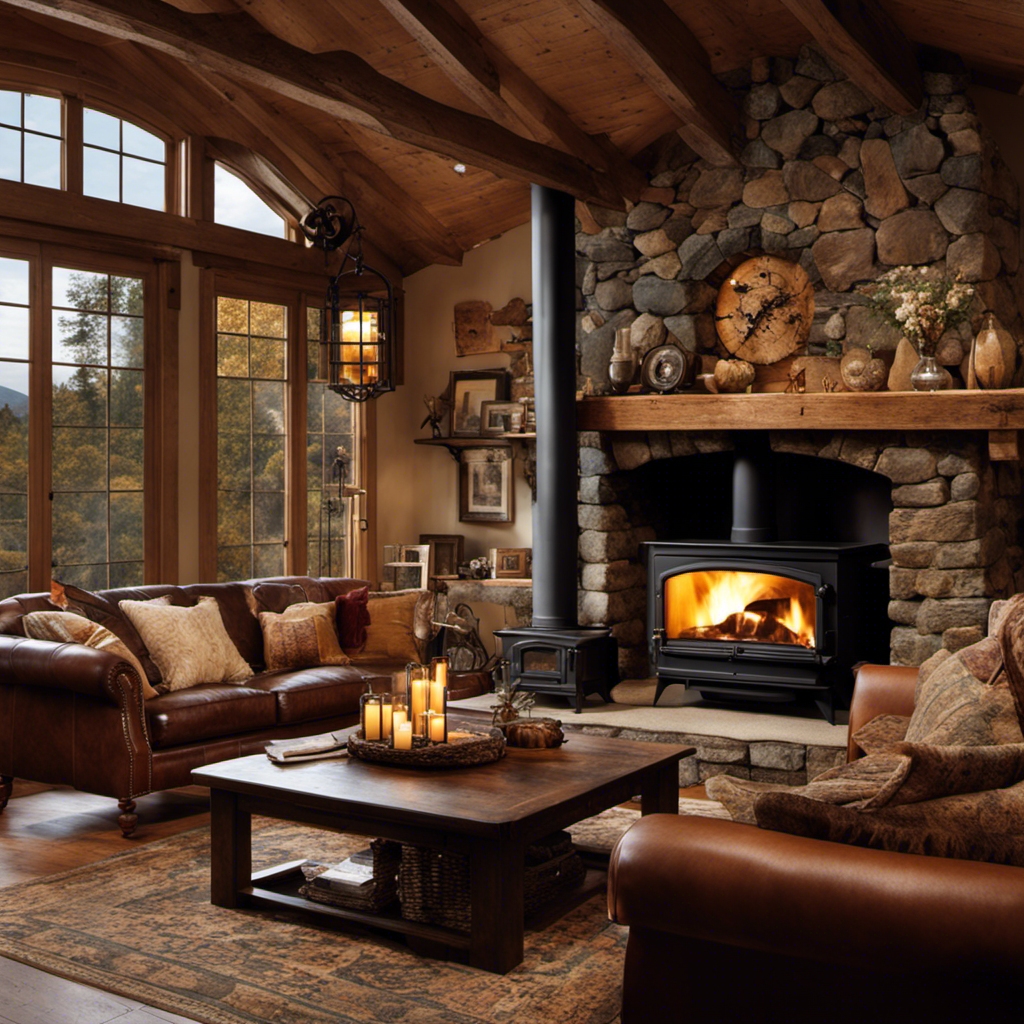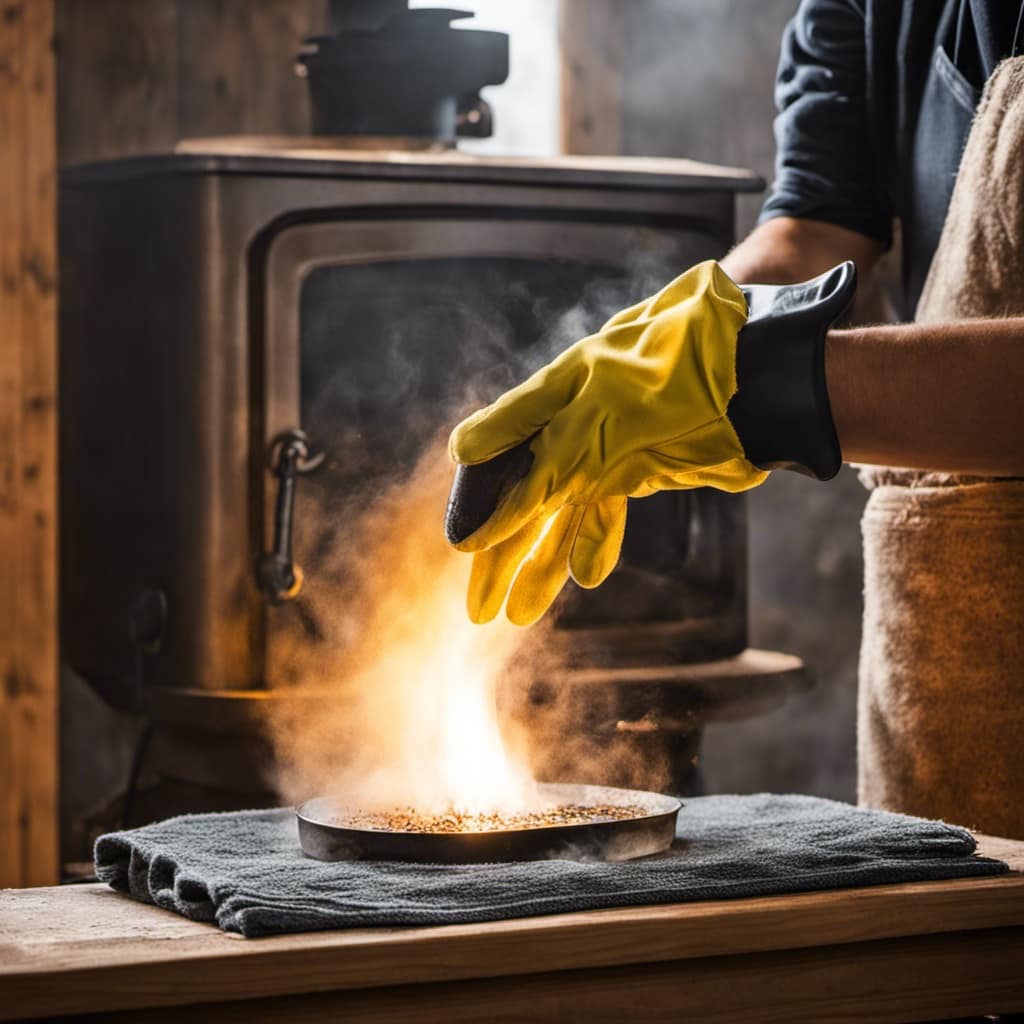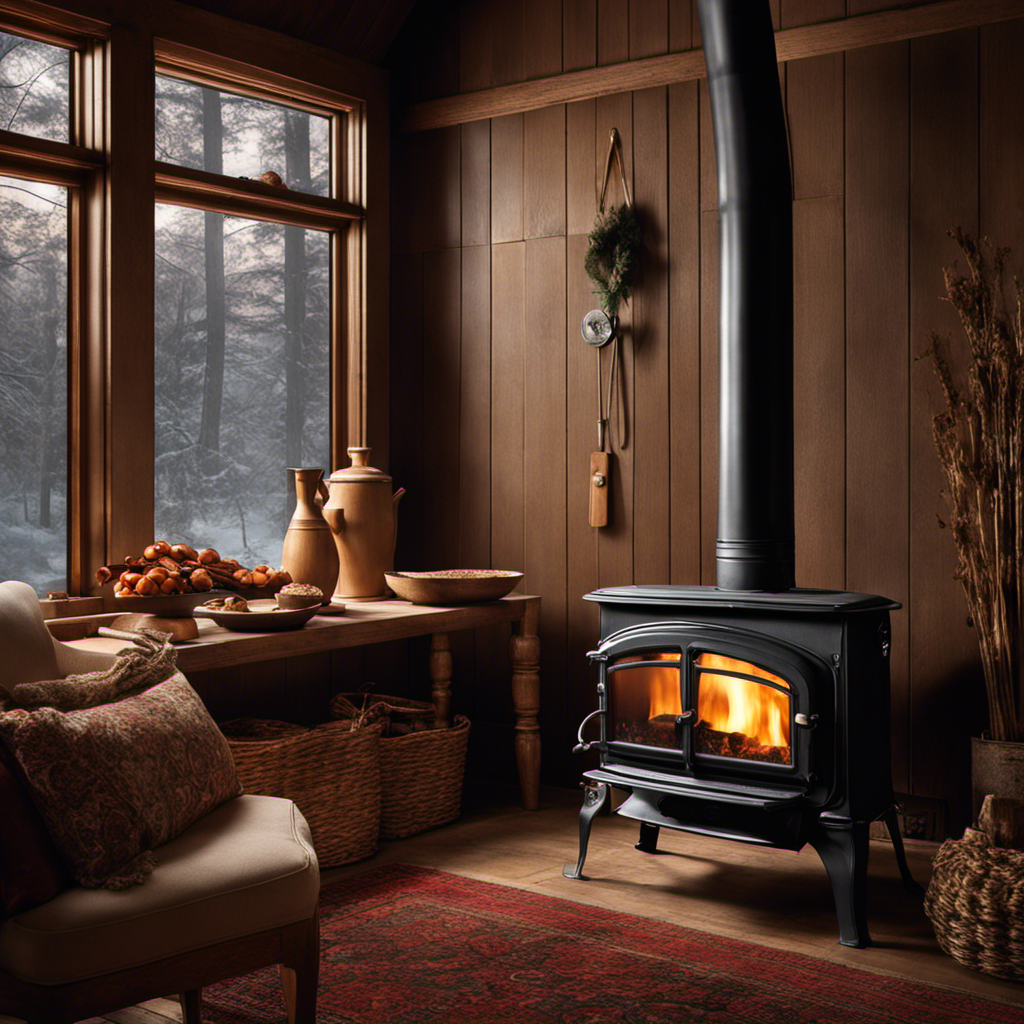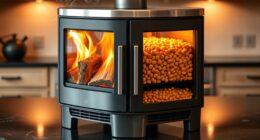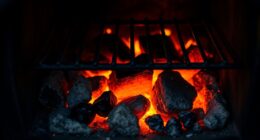To properly season firewood for your wood stove, split the logs into smaller pieces to increase drying surface area. Stack the wood off the ground, using pallets or log racks to promote airflow. Store it in a well-ventilated area, covering only the top with a tarp to shield it from rain while keeping the sides open for circulation. Aim for a minimum seasoning period of six months, guaranteeing moisture content falls below 20%. Regularly check the dryness with a moisture meter to confirm readiness. This method not only guarantees efficient burning but also enhances safety in your home. You'll find further tips to perfect your firewood seasoning technique.
Key Takeaways
- Split logs into smaller pieces to increase surface area for faster drying and more efficient seasoning.
- Stack firewood off the ground to prevent moisture absorption and promote airflow for even drying.
- Cover only the top of the wood stack with a tarp to protect against rain while allowing ventilation from the sides.
- Ensure firewood seasons for at least six months, aiming for a moisture content below 20% for optimal burning.
- Regularly check moisture levels using a moisture meter to confirm the wood is adequately seasoned before use.
Importance of Seasoning Firewood
When it comes to getting the most out of your wood stove, seasoning firewood is vital. Properly seasoned firewood reduces its moisture content to below 20%, which is essential for efficient burning and maximizing heat output. Freshly cut wood can have moisture levels as high as 100%, leading to poor combustion and energy loss as water evaporates during burning. You want to avoid this scenario to guarantee your wood stove works effectively.
Additionally, using seasoned wood enhances overall heating performance and can even reduce the need for frequent chimney maintenance, similar to how using top-rated garage door openers improves home security and efficiency.
Using seasoned wood not only improves heat efficiency but also minimizes the risk of creosote build-up in your chimney. Inadequate seasoning can create hazardous burning conditions, increasing the likelihood of chimney fires.
To achieve ideal results, make sure to split, stack, and store your firewood in a well-ventilated area for at least six months. This allows for proper air circulation and effective moisture loss.
Identifying Quality Seasoned Firewood
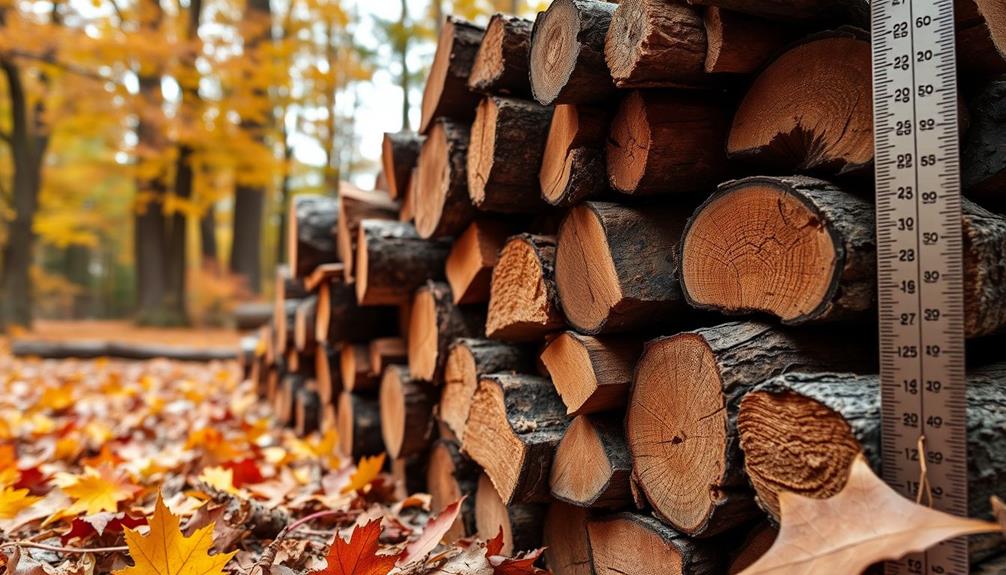
Knowing how to identify quality seasoned firewood is just as important as understanding why it's necessary. When you select seasoned firewood, look for wood with a moisture content below 20%, ideally around 10%. This guarantees efficient burning and ideal heat output, making it an essential factor for those using wood stoves or the functionality of wood pellet fireplaces.
A good indication of properly seasoned wood is its grey tone, along with visible cracks and splits on the ends. These signs suggest prolonged drying and lower moisture levels.
You'll also notice that seasoned wood feels lighter than unseasoned wood, as the moisture has evaporated, which can greatly impact its burning efficiency.
Pay attention to the bark; seasoned wood typically has loose bark that can be easily removed, while unseasoned wood will have tightly adhered bark.
Finally, when you strike seasoned pieces together, you should hear a hollow sound, indicating dryness. In contrast, wet wood produces a dull thud.
Effective Storage Techniques

To guarantee your firewood seasons effectively, focus on proper storage techniques. Properly seasoned firewood can enhance your heating efficiency and reduce smoke emissions.
Elevating the wood off the ground prevents moisture absorption, while arranging it for maximum airflow promotes even drying. Additionally, covering the top protects your wood from rain and snow, keeping it dry and ready for use.
Indoor water parks offer great options for family fun during winter months.
Air Circulation Importance
Effective air circulation is vital for seasoning firewood properly. It allows moisture to escape from the wood, reducing its moisture content below the ideal 20% for efficient burning.
To enhance air circulation, consider stacking your firewood in a crisscross pattern. This method promotes airflow between logs, facilitating quicker drying and preventing moisture pockets from forming. Regularly using an air purifier can also help improve the overall environment where your firewood is stored, guaranteeing that dust and allergens don't settle on your wood which can affect air quality.
You should keep the sides of your woodpile open to enhance ventilation, allowing air to flow freely. Cover only the top with a tarp or a similar material to protect against rain and snow while still letting moisture escape. This balance is essential in properly seasoning your firewood.
Additionally, regularly check your woodpile for signs of mold or insect infestations. These issues can hinder proper air circulation and compromise the quality of your seasoned wood.
Elevation From Ground
Your firewood's quality can greatly improve by elevating it off the ground. By stacking your wood at least 5-6 inches above the earth, you markedly reduce moisture absorption from the soil, which can hinder the seasoning process. This elevation allows air to circulate underneath the stack, promoting efficient drying and minimizing the risk of mold growth.
| Benefit | Description |
|---|---|
| Improved Airflow | Elevation allows air to circulate, aiding drying. |
| Reduced Moisture | Prevents moisture absorption from damp ground. |
| Pest Protection | Keeps wood safe from insects attracted to wet wood. |
When you properly season your firewood, keeping it elevated also helps maintain a clean storage area. It minimizes debris accumulation, making it easier to access your wood when you need it. A well-ventilated storage solution, like a covered wood rack, not only keeps your wood dry but also exposes it to sun and wind, further enhancing the seasoning process. So, take the time to elevate your firewood; your future self will appreciate the effort!
Covering Techniques for Protection
A proper covering technique is vital for protecting your seasoned firewood from the elements while guaranteeing it continues to dry effectively. To meet your firewood needs, cover the top of your stack with a tarp or dedicated wood cover. This will shield it from rain and snow while allowing moisture to escape.
Incorporating natural materials like wood for your storage solutions can enhance the overall aesthetic of your outdoor space, blending functionality with style, as seen in modern farmhouse decor trends. It's important to leave the sides exposed, as plenty of air circulation is necessary for drying and preventing mold growth.
Storing your firewood off the ground, using pallets or a log rack, also helps combat moisture absorption from the soil. Aim for breathable covers like canvas or mesh tarps; these materials let moisture escape while guarding against precipitation. Avoid plastic covers, as they can trap humidity and lead to damp conditions.
Regularly inspect your covered firewood to verify it remains dry and free from pests. Damp wood can rot and diminish your burning efficiency, making it harder to season wood properly.
Risks of Unseasoned Firewood
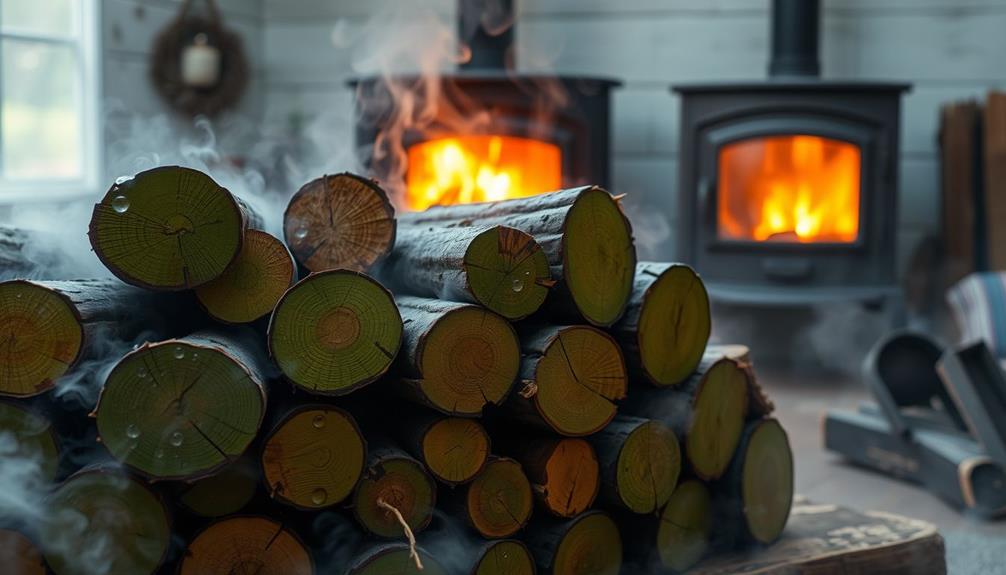
Burning unseasoned firewood poses several significant risks that can affect both your home and health. One of the main issues with unseasoned wood is its high moisture content, which leads to inefficient fires. You'll find that these fires produce less heat and waste fuel, leaving you feeling cold and unsatisfied.
Additionally, unseasoned wood creates a poor draft, causing smoke to back up into your living space. This can lead to dangerous conditions and contribute to poor indoor air quality, which may cause respiratory issues. Moreover, just as improper disposal practices can lead to plumbing issues, using unseasoned wood can also result in compromised safety measures related to your home heating system.
Moreover, burning unseasoned wood increases creosote buildup in your chimney. Over time, this buildup can ignite and lead to a chimney fire, posing a severe hazard to your home.
The excessive smoke produced by unseasoned wood not only fills your rooms but also releases harmful particulates and gases into the environment, contributing to pollution.
In short, using unseasoned wood compromises your safety and comfort. Prioritizing properly seasoned firewood is essential to avoid these risks and guarantee a warm, healthy home.
Benefits of Proper Preparation
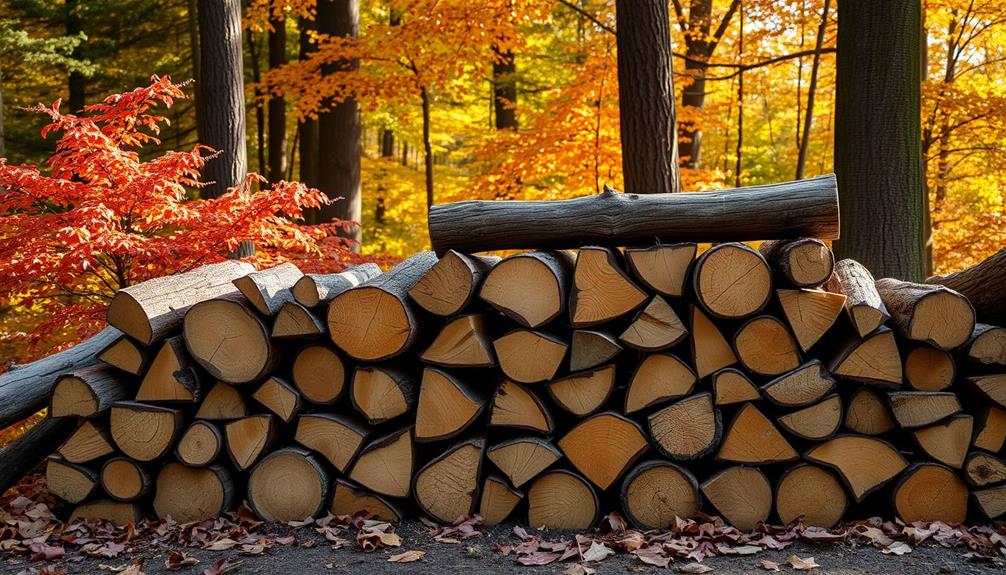
When you properly prepare your firewood, you'll notice enhanced burning efficiency, which means more heat and less waste.
This also leads to reduced creosote buildup in your chimney, lowering the risk of chimney fires.
Additionally, using well-seasoned wood can contribute to a more stable indoor temperature, similar to how a well-functioning heat pump system operates effectively.
Enhanced Burning Efficiency
Seasoning your firewood is crucial for achieving improved burning efficiency. When you use properly seasoned firewood, with a moisture content below 20%, you maximize heat output while minimizing the need for additional fuel.
Seasoned wood ignites quickly and produces a hotter fire, greatly improving your burning efficiency. Just like how butter enhances flavor, properly seasoned wood contributes to a better overall burning experience. By seasoning your wood for at least six months, you confirm it dries adequately, allowing for a cleaner burn.
Utilizing a moisture meter can help you determine when your wood is ready for use. Burning seasoned wood not only helps you enjoy longer-lasting fires but also cuts fuel costs, making your heating efforts more economical.
The efficiency of seasoned wood means you'll spend less time and money on fuel, as it generates more heat per log compared to unseasoned wood.
Moreover, the cleaner burn associated with properly seasoned firewood contributes to a healthier indoor environment by minimizing harmful emissions.
Reduced Creosote Buildup
Using properly seasoned firewood can greatly reduce creosote buildup in your chimney. When you burn seasoned wood with a moisture content below 20%, you considerably lower the formation of creosote, which is a flammable byproduct that accumulates in chimneys.
Additionally, utilizing eco-friendly heating methods, such as geothermal energy, can complement your efforts in maintaining a clean and efficient home. In fact, using seasoned firewood instead of unseasoned wood can decrease creosote buildup by up to 90%, leading to a safer and more efficient burn.
Burning seasoned wood minimizes the smoldering effect that contributes to creosote formation, ensuring a clean burn. This not only enhances your heat output but also reduces the frequency of chimney cleanings.
With lower emissions from seasoned wood, you'll find that creosote accumulates less overall, which means fewer maintenance needs for your chimney.
Steps for Seasoning Firewood

To effectively season firewood for your wood stove, start by splitting the logs into smaller pieces. This increases the surface area, which expedites the drying process and enhances burning efficiency.
Once you've split the wood, follow these steps for maximum seasoning:
- Stack the split wood off the ground using pallets or log racks to prevent moisture absorption. Proper stacking is essential, much like how a reliable home cleaning service organizes its tasks efficiently.
- Cover only the top of the stacked wood with a tarp or roof to protect it from rain while keeping the sides open for ventilation.
- Allow a minimum seasoning period of six months, but aim for one year to guarantee the wood's moisture content drops below 20%.
- Regularly check the wood for dryness, using a moisture meter if you have one, to confirm it's reached the perfect moisture content.
Tools for Firewood Management
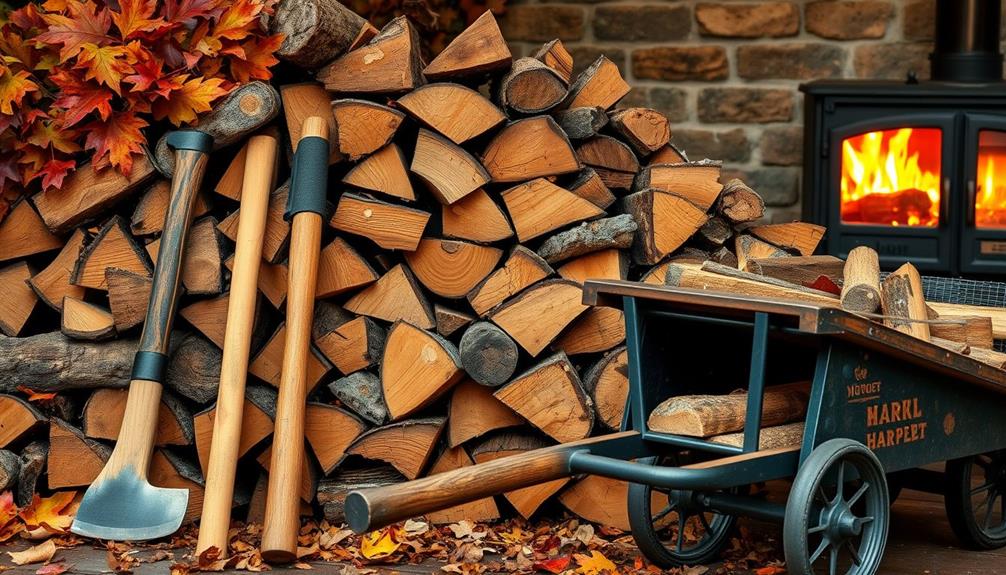
When managing firewood, having the right tools can make all the difference in efficiency and effectiveness. Start with efficient splitting tools like the Fiskars X27 axe, which can easily break down logs into manageable pieces. This not only enhances the drying process but also improves burning efficiency.
Next, invest in a moisture meter to accurately assess the moisture content of your firewood. For seasoned wood, you want levels below 20% for ideal burning conditions.
Proper storage is essential as well. Using firewood log racks allows for adequate airflow around your woodpile, preventing moisture accumulation and promoting effective seasoning.
A sturdy box for splitting wood can help you stack the pieces neatly and guarantee uniform sizes, aiding in both drying and burning consistency.
Additionally, secure roofing materials or weights can protect your stored firewood from wind displacement and moisture intrusion. This helps keep your wood dry, making sure you're always ready for a warm fire when you need it.
With these tools, you'll streamline your firewood management, making your wood stove experience even more enjoyable.
Frequently Asked Questions
How Do You Season Wood for a Wood Stove?
To season wood, split it into smaller pieces for faster drying. Stack it in a sunny, well-ventilated area, cover the top, and regularly check for dryness until it reaches a moisture content below 20%.
How Long Does Firewood Need to Cure?
While some wood dries quickly, others take time. You'll need at least 6 months for softwoods and a year for hardwoods to cure properly. So, plan ahead to guarantee you're prepared for colder months.
How Can You Tell if Firewood Is Seasoned Enough?
To tell if your firewood's seasoned enough, look for cracks in the ends, a lighter weight, loose bark, and a hollow sound when struck. Using a moisture meter can also confirm it's below 20% moisture content.
Does Firewood Season Better, Covered or Uncovered?
Firewood seasons better when it's covered on top, protecting it from rain and snow, while leaving the sides open for airflow. This balance prevents moisture accumulation and promotes efficient drying for ideal seasoning.
Conclusion
In the grand dance of warmth and comfort, properly seasoned firewood is your partner. By embracing the art of seasoning, you're not just stoking the flames; you're ensuring a cozy, efficient fire that whispers tales of crackling joy rather than the frustrations of smoke-filled rooms. So, take the time to prepare your firewood, and let your wood stove serenade you with its inviting glow. You'll find every moment spent is a step towards a perfect evening.

